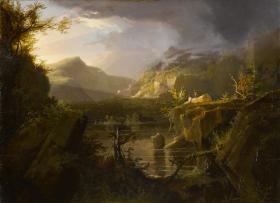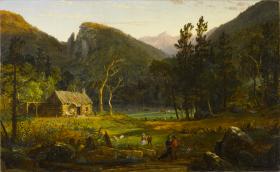1. Have the class look closely at Romantic Landscape and brainstorm a list of adjectives to describe the painting. List these on the board. Ask them:
- What details or qualities of the painting made you think of that particular adjective?
- Where are the people in this picture? Who might they be?
- Why don't the people have a larger presence in this painting?
- What might Thomas Cole be suggesting by limiting the portrayal of people in the painting?
- What time period in American history is the artist portraying? Before or after European colonization? Why?
- What kinds of symbols has the artist included and why? (dead tree in the foreground, the mountains, the threatening sky)
2. Provide a brief overview explaining the major points in Frederick Jackson Turner's frontier thesis (under Chapter I.) Use the material in the biographical sketch "Frederick Jackson Turner; 1861-1932)" to prepare.
3. Assign each student to read the excerpt from Frederick Jackson Turner's essay "The Significance of the Frontier in American History."
Hold a class discussion focused on the following questions:
- What does Frederick Jackson Turner's essay assert happened to both the wilderness and the Native American in Cole's painting?
- Why does Turner believe this happened?
- What is the result?
4. Assign each student to draw a picture depicting one scene as he or she envisions it, based on information contained in the excerpt from Frederick Jackson Turner's essay "The Significance of the Frontier in American History." The students should write a caption to describe the event(s) in the picture. Have several students share their work and explain their compositional choices.
5. Have the students examine Eagle Cliff, Franconia Notch, New Hampshire.
Assign each student to write an essay responding to the following prompt:
Assess Jasper Cropsey and Frederick Jackson Turner’s visions for the role of Native Americans in the development of the United States. Consider why Turner's understanding of the Native Americans' role in American history might be problematic.
• The teacher will use the list of adjectives, class discussion, and essay to assess the students’ analysis of the composition of the painting and their understanding of the symbolism of the American frontier.
• The class discussion, drawing, and essay may be used to assess the students’ understanding of Frederick Jackson Turner’s essay and the symbolism of the American frontier.
• The teacher will use the essay to assess the students’ ability to construct an analysis using historical evidence to support arguments.
Americanization
biographical
Cherokee
foreground
frontier
glaciations
Iroquois
moccasin
moraines
palisade
symbolism
tabula rasa
paper and markers, pencils, or paints
For Thomas Cole, landscape painting was more than the depiction of scenery. Through his paintings of the vast American wilderness, the artist hoped to stir the viewer to contemplate the natural purity and boundless promise of the New World. Both his art and his spiritual zeal inspired several generations of American landscape painters known collectively as the Hudson River school.
This small painting dates from Cole's early career, when the young painter was first exploring the dramatic possibilities of landscape art. Based on studies made in New York's Catskill Mountains, the composition presents a romantic, deeply moral vision of primeval nature, its wildness contrasting with the "civilized" landscapes of Europe. That Cole intended such paintings as hymns to nature and nature's God is evident in his poetry, particularly "Lines from Lake George", written in the same year as this painting:
O may the voice of music that so chime
With the wild mountain breeze and rippling lake
Ne'er wake the soul but to a keener sense
Of nature's beauties...
The pioneering family blazing a new life in the wilderness is one of the great American stories. In the mid-nineteenth century, the earnest and self-reliant homesteader exemplified the spirit of the young Republic. Many artists like Jasper Cropsey celebrated a romantic vision of backwoods America. Derived from sketches made in the White Mountains of New Hampshire, this painting shows a recently cleared farm with a young family going about the morning chores. Though the precariousness of the family's existence is perhaps implied by the dark, encircling forest, the valley itself is bathed in the hopeful light of morning.
By their industry the forest has surrendered to fields and pasture: livestock graze, grain awaits cutting, and vegetables ripen in the garden. In the foreground the farmer and an American Indian converse beside a newly laid corduroy (or log) road that promises an end to the valley's isolation.



